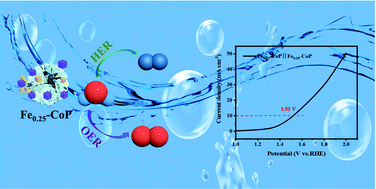Construction of Fe-doped CoP with hybrid nanostructures as a bifunctional catalyst for overall water splitting†
Abstract
Due to their open skeleton structures, adjustable active sites and homogeneous catalytic centers, PBA-based materials have promising applications in electrochemical water splitting. Herein, we report a PBA derived Fe0.25-CoP electrocatalyst with a hybrid nanostructure, which offered a large specific surface area and active sites for the HER and OER, respectively. The as-synthesized Fe0.25-CoP catalyst exhibits remarkable catalytic performance and durability at overpotentials of 262 mV for the OER and 111 mV for the HER, requiring a voltage of merely 1.57 V to achieve a current density of 10 mA cm−2 for the electrocatalytic water splitting process. The preeminent activity of Fe0.25-CoP was mainly ascribed to the framework structures of Co-PBA and appropriate doping of Fe3+ which regulated the electronic structures and morphology of Fe0.25-CoP. In addition, the partial phosphating strategy retained the active centers for the OER in Co-PBA, which were further enhanced by the catalysis of Fe3+. In short, the rational design and regulation of catalyst structures and compositions is a promising approach for the development of highly efficient water splitting catalysts.



 Please wait while we load your content...
Please wait while we load your content...